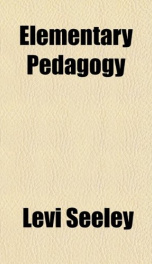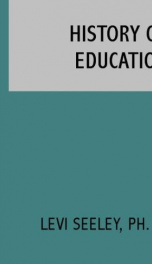elementary pedagogy

Purchase of this book includes free trial access to www.million-books.com where you can read more than a million books for free. This is an OCR edition with typos. Excerpt from book: CHAPTER II THE AIM OF EDUCATION References. Rosenkranz, Philosophy of Education; Prince, Courses and Methods; McMurry, General Method; Spencer, Education; Payne, Contributions to the Science of Education; Parker, Talks on Pedagogics; De Motte, Character Building; Payne, Education of Teachers; Roark, Method in Education; Coler, Character Building; Home, Philosophy of Education; Shearer, Morals and Manners; Smith, Systematic Methodology; White, School Management; Elements of Pedagogy; Laurie, Primary Instruction; Barnett, Common Sense in Education and Teaching; Briggs, School, College, and Character. The question, "What is the aim of education?" has engaged the attention of thinkers for many centuries. The answer to it has been colored by national characteristics, by the needs of a people, by the spirit that has dominated the age, and by the state of civilization attained. Indeed, the answer to this question may have had a great deal to do in forming the character of individuals and of nations, and in making prominent certain influences which have affected the world in different ages. In China, for example, the aim of education for thousands of years has been to maintain the established order of society, and to teach respect for traditions and ancestral customs. In India, it was to preserve the ancient castes, and prepare for absorption into Nirvana. In Persia and Sparta, it was to prepare for war, to give physical strength, and foster moral rectitude. To the early Jews, it meant training to respect law, and reverence Jehovah. Athens would have a beau- tiful soul in a beautiful body, while the ideal in Rome was "To make a man fit to perform justly, skilfully, and magnanimously all the offices, both public and private, of peace and war." The aim of education according ...
Info about the book
Author:
Series:
Unknown
ISBN:
0554960532
Rating:
3.5/5 (1)Your rating:
0/5
Languge:
English
Users who have this book
Users who want this book
What readers are saying
What do you think? Write your own comment on this book!
write a commentif you like elementary pedagogy try:
Do you want to read a book that interests you? It’s EASY!
Create an account and send a request for reading to other users on the Webpage of the book!






